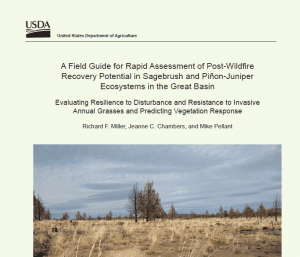Research and Publications
View article.
This study tested the stress-gradient hypothesis (SGH) in observations of 75 sites along overlapping water and heat stress and disturbance gradients. As stress-disturbance levels increase, sagebrush-herbaceous plant facilitation levels increase, the landscape will become increasingly aggregated as a product of necessary facilitation between sagebrush and herbaceous plants. This aggregation decreases the individual resilience of the native herbaceous plants, increases the competition from invasive plants, and decreases the overall stability and resilience of the sagebrush steppe ecosystem.
View article.
This study used survey data from three 2010 wildland fires to understand how ecological knowledge and education level affected fire management perception and understanding. Results indicated that increased accuracy in identifying ecological conditions was associated with higher proficiencies in the identification of fire management strategies used for wildfires. Education levels were not significantly related to public perception of fire management but were related to significant differences in accurately identifying ecological conditions. Results suggest that education may play a mediating role in understanding complex wildfire issues but is not associated with a better understanding of fire management.
View field guide.
This field guide provides a framework for rapidly evaluating post-fire resilience to disturbance, or recovery potential, and resistance to invasive annual grasses, and for determining the need and suitability of the burned area for seeding. The framework identifies six primary components that largely determine resilience to disturbance, resistance to invasive grasses, and potential successional pathways following wildfire, as well as the information sources and tools needed to evaluate each component.
The components are: (1) characteristics of the ecological site; (2) vegetation composition and structure prior to the wildfire; (3) fire severity; (4) post-wildfire weather; (5) post-wildfire management, especially grazing; and (6) monitoring and adaptive management.
The tools provided are: (1) a conceptual model of the key components that largely determine resilience to disturbance and resistance to invasive annual grasses of the burn area, (2) a guide to evaluate post-wildfire severity, (3) indicators to estimate pre-wildfire plant composition and structure if not known, and (4) an evaluation score sheet to rate an area’s potential post-wildfire resilience to disturbance, resistance to invasive annual grasses and, thus, the need for seeding and probability of success.
View abstracts.
These abstracts of recent papers on rangeland management in the West were prepared by Charlie Clements, Rangeland Scientist, USDA Agricultural Research Service, Reno, NV.
View article.
This study found that early seral natives generally outperformed late seral natives when growing with exotics and had earlier emergence timing, although results differed among functional groups and soil types. Survival probabilities, however, did not differ between the early and late seral mixes when growing without exotics. Within each seed mix, native grasses exhibited the highest emergence probabilities of the functional groups. Natives did not suppress exotics in early life stages. Performance of B. tectorum was higher on sandy loam, while T. caput-medusae was highly successful in both soil types. Performance of native functional groups differed by soil type when growing with exotics but did not differ when growing without exotics. Survival of native grasses, in particular, was generally higher on sandy loam when growing with exotics.
View the plan.
The Science and Traditional Ecological Knowledge Strategic Plan guides the Great Basin LCC’s science program over a three to five year period (2015-2019). The plan outlines the LCC’s priority topics and how they will be updated, describes the process to determine annual focal topics and activities, and outlines how the LCC will implement, evaluate and adjust the science program.
Priority topics are:
- Adaptation to changes in water availability, temperature, climate variability, and extreme climatic events
- Adaptation to changes in ecosystem structure, processes, function, and interactions
View report.
This final report includes actions to be implemented by Interior’s bureaus to immediately address the threat of rangeland fire and other disturbances to Western sagebrush-steppe landscapes and improve fire and fuels management efforts.
View abstracts.
Abstracts of recent papers on climate change and land management in the West. Prepared by Louisa Evers, Science Liaison and Climate Change Coordinator, Bureau of Land Management, Oregon-Washington State Office.
View article.
This study monitored the habitat-use patterns of 71 radio-marked sage-grouse inhabiting an area affected by wildfire in the Virginia Mountains of northwestern Nevada during 2009–2011 to determine the effect of micro-habitat attributes on reproductive success. Sage-grouse selected micro-sites with greater shrub canopy cover and less cheatgrass (Bromus tectorum) cover than random sites. Total shrub canopy, including sagebrush (Artemisia spp.) and other shrub species, at small spatial scales (0.8 ha and 3.1 ha) was the single contributing selection factor to higher nest survival. These results indicate that reducing the risk of wildfire to maintain important sagebrush habitats could be emphasized in sage-grouse conservation strategies in Nevada. Managers may seek to mitigate the influx of annual grass invasion by preserving large intact sagebrush-dominated stands with a mixture of other shrub species. For this area of Nevada, the results suggest that ≥40% total shrub canopy cover in sage-grouse nesting areas could yield improved reproductive success.
View research brief.
This research brief summarizes a series of interviews with land managers who make decisions about post-fire rehabilitation and restoration. These interviews explored barriers to improving post-fire recovery that included: policies and funding cycles that constrain managers’ ability to monitor and re-treat effectively, pressure and legal action from interest groups, pressure from concerned public/neighbors, climate change, and ecological debates such as native vs. non-native species use. These identified barriers provide a social-political-ecological framework that may influence on-the-ground manager decisions after wildfires in the Great Basin.


